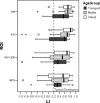Regional differences in the developmental trajectory of lateralization of the language network
- PMID: 23033058
- PMCID: PMC3578038
- DOI: 10.1002/hbm.22179
Regional differences in the developmental trajectory of lateralization of the language network
Abstract
The timing and developmental factors underlying the establishment of language dominance are poorly understood. We investigated the degree of lateralization of traditional frontotemporal and modulatory prefrontal-cerebellar regions of the distributed language network in children (n = 57) ages 4 to 12--a critical period for language consolidation. We examined the relationship between the strength of language lateralization and neuropsychological measures and task performance. The fundamental language network is established by four with ongoing maturation of language functions as evidenced by strengthening of lateralization in the traditional frontotemporal language regions; temporal regions were strongly and consistently lateralized by age seven, while frontal regions had greater variability and were less strongly lateralized through age 10. In contrast, the modulatory prefrontal-cerebellar regions were the least strongly lateralized and degree of lateralization was not associated with age. Stronger core language skills were significantly correlated with greater right lateralization in the cerebellum.
Keywords: fMRI; language; lateralization; pediatric.
Copyright © 2012 Wiley Periodicals, Inc.
Figures




References
-
- Ackermann H, Mathiak K, Riecker A (2007): The contribution of the cerebellum to speech production and speech perception: Clinical and functional imaging data. Cerebellum 6:202–213. - PubMed
-
- Ahmad Z, Balsamo LM, Sachs BC, Xu B, Gaillard WD (2003): Auditory comprehension of language in young children: Neural networks identified with fMRI. Neurology 60:1598–1605. - PubMed
-
- Ashburner J (2007): A fast diffeomorphic image registration algorithm. Neuroimage 38:95–113. - PubMed
-
- Balsamo LM, Xu B, Gaillard WD (2006): Language lateralization and the role of the fusiform gyrus in semantic processing in young children. Neuroimage 31:1306–1314. - PubMed
-
- Balsamo LM, Xu B, Grandin CB, Petrella JR, Braniecki SH, Elliott TK, Gaillard WD (2002): A functional magnetic resonance imaging study of left hemisphere language dominance in children. Arch Neurol 59:1168–1174. - PubMed
Publication types
MeSH terms
Grants and funding
LinkOut - more resources
Full Text Sources

